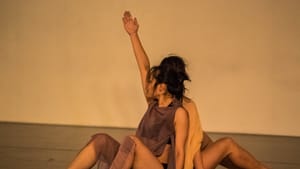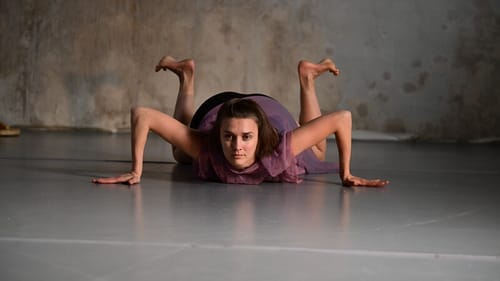Stay in the Loop
BSR publishes on a weekly schedule, with an email newsletter every Wednesday and Thursday morning. There’s no paywall, and subscribing is always free.
Diverse paths in dance converge
Crossing Paths Movement Collective presents its Philly premiere

The Philadelphia debut of Crossing Paths Movement Collective offered celebration and reckoning in nine works. As choreographer Malcolm Shute noted before the show, the performance honored art created during the pandemic, the fortitude of people who endured, and the memory of those who perished. In particular, Nick M. Daniels’s use of video and sound, Sarah Carlson’s explorations of women’s experiences, Evalina “Wally” Carbonell’s touches of whimsy, and Shute’s contact choreography, which uses touch to portray human relationships, made these themes apparent in striking and sometimes moving ways.
The program included two pieces each from Carlson, Daniels, and Shute, and three works by Carbonell, an independent creator and a dancer with Kun-Yang Lin/Dancers. The dances truly crossed paths through the distinct, yet complementary, styles of the movement artists and choreographers. Some pieces stood out for their strength and ingenuity, but all had something to offer.
Choreography and connection
Shute’s Cascade and Personal Space were highlights. Pairing contact choreography with gesture, they were performed at a slow pace with constant movement for an effect both visually captivating and evocative. The movement suggested interdependence as well as Covid-era cravings for human connection.
In Cascade, set to Albinoni’s “Adagio in G Minor,” Susan Donham, Roxann Morgan Rowley, Alexander Short, and Shute formed a kinetic shape that was part human pyramid, part nesting doll as their bodies folded into and rested upon each other. Clad in black tops and bottoms spattered with white paint, the dancers leaned on one another, supported each other’s bodies, and reached hands to each other’s shoulders and cheeks in gestures of caring, support, and solidarity. As these constantly shifted, they effectively captured the ever-evolving dynamics of human relationships and the necessity of giving and receiving.
In Personal Space, Katie Sopoci Drake and Shute performed a duet with similar features while sitting, lying, balancing, and moving together on a table. The dancers maintained contact between their bodies as they shifted positions and bore each other’s weight. Personal Space delved even deeper into relationships as it depicted the sensual and romantic aspects of human intimacy.
A social perspective
The two pieces Daniels created and performed, both excerpted from longer works, approached relationships from a broader social perspective. African/American and Here’s the Story combined video, virtual environments, soundscapes, text, and music with movement to examine identity, power, and justice. More performance art than dance, Daniels’s work added breadth and depth to the program but might be more effective in another format. Live and recorded elements competed for attention, while the butoh-inspired movement could not match the power of the images and themes. For instance, African/American juxtaposed a black-and-white projection of the nation’s flag with arresting video footage of Nkyinkim, Kwame Akoto-Bamfo’s sculpture dedicated to the victims of the transatlantic slave trade. Here’s the Story considered Black bodies in a similar fashion, largely using sound and images to reflect on how society views and interacts with them.
Movement and message
Carlson achieved an effective partnership between movement and message with In Our Hands, one of the program’s standout pieces. This dance addressed identity and interdependence, and its all-female cast suggested an exploration of women’s experiences. Costuming contributed to this effect, with Carlson, Ciara Alford, Rachel Halkias, Karen Fox, Jessica Minor, and Yesenia Paula each wearing her own version of a black outfit to reflect the diverse ways in which people experience a shared trait such as gender.

In Our Hands also portrayed this theme through movement. In one memorable scene, dancers took turns standing in the center of a circle. The others reached toward and touched the woman in the middle with gestures that ranged from reverential to aggressive before quickly turning away from her so another could enter the circle. Later, dancers formed pairs in which one jumped vertically while her partner pushed her hips, so that the jump landed farther away. Did the pushes assist or hinder? Through leaving this open to interpretation, In Our Hands raises compelling questions about how we hurt those we aim to help and vice versa, as well as the ways in which we understand ourselves in relation to each other.
Carlson’s other piece, Imagining Her, addressed a medical exam recommended annually for women over 40. Carlson performed the solo in rose-colored scrubs, her movements alternately matching the audio’s robotic x-ray machine sounds and verbal instructions of a mammography technician. Imagining Her may have confused those who have not yet joined, or will never join, a club that a Jefferson Breast Imaging Center employee called “the big girls club” on the day of my first screening. However, it movingly depicted a little-discussed and often scary experience common to more than half the population.
A richly diverse experience
Less topical and introspective than the other works, Carbonell’s Apple, Sycamore, and Koyl added whimsy and grace to the program. The artist’s young child Lina Carbonell contributed to the former by appearing in the tree-themed dances, handing apples to audience members in the first and distributing leaves across the space in the second. The red dress Carbonell wore contrasted with her daughter’s green one in Apple, a meditation on forbidden fruits sometimes freely given, sometimes procured with great effort.
Carbonell’s choreography often contrasts flowing movement with abrupt motions and gestures, and while many works of contemporary dance share this feature, it’s not a favorite. The strongest sections included synchronous dancing, such as when Carbonell, Weiwei Ma, and Grace Stern moved together before taking turns peeling away for solos in Sycamore. In Koyl, sheer, flowing skirts enhanced the elegance and drama of Ma’s and Stern’s high kicks.
Crossing Paths Movement Collective offered reflection on and celebration of human experience, as well as a richly diverse experience of dance, from distinct styles of movement and performance to a lineup of dancers refreshingly diverse in age, gender, body type, race, and ethnicity. I look forward to crossing paths with these artists again.
What, When, Where
Crossing Paths Movement Collective. March 19 through 20, 2022, at CHI Movement Arts Center, 1316 S. 9th Street, Philadelphia.
The CHI Movement Arts Center requires proof of full Covid-19 vaccination. No masks required.
Accessibility
CHI Movement Arts Center is a wheelchair-accessible venue, with an accessible restroom located backstage and available on request.
Sign up for our newsletter
All of the week's new articles, all in one place. Sign up for the free weekly BSR newsletters, and don't miss a conversation.
 Melissa Strong
Melissa Strong